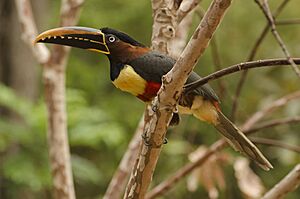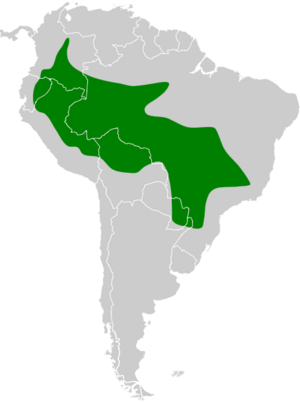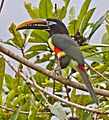Chestnut-eared aracari facts for kids
Quick facts for kids Chestnut-eared aracari |
|
|---|---|
 |
|
| in Chapada dos Veadeiros, Brazil | |
| Conservation status | |
| Scientific classification | |
| Genus: |
Pteroglossus
|
| Species: |
castanotis
|
| Subspecies | |
|
See text |
|
 |
|
The chestnut-eared aracari (Pteroglossus castanotis) is a colorful bird from the toucan family. It lives in many countries in South America. You can find it in Argentina, Bolivia, Brazil, Colombia, Ecuador, Paraguay, and Peru.
Contents
Meet the Chestnut-eared Aracari
What are Subspecies?
Scientists recognize two main types, or subspecies, of the chestnut-eared aracari. These are P. c. castanotis and P. c. australis. They are very similar but have small differences.
How to Spot This Bird
The chestnut-eared aracari is about 43 to 47 centimeters (17 to 18.5 inches) long. It weighs between 220 and 310 grams (7.8 to 10.9 ounces). Both male and female birds have colorful beaks, but the female's beak is a bit shorter.
The main type of aracari has a yellow line at the base of its beak. The lower part of its beak is mostly black. The top part has a black stripe and orange-yellow colors. It also has black and ivory marks on the edge that look like teeth!
Male birds have a black head and neck. Their back is dark green, and their rump (the area above the tail) is red. They have blue skin on their face. Their throat can be brown or chestnut. Their chest is yellow, and their belly is also yellow.
Female birds are a bit browner on their head and neck. The black band on their lower throat is also thinner. Young birds are not as brightly colored. Their beaks don't have the "teeth" pattern or the yellow line yet.
The P. c. australis subspecies is usually paler than the main type. Its cheeks and upper throat are more rusty-colored. Its chest band is red and rufous. This type also has a wider orange line on its beak.
Where Do They Live?
Their Home in South America
The chestnut-eared aracari lives in the western and southern parts of the Amazon Basin. The P. c. castanotis subspecies lives more to the north. You can find it from southern Colombia, through Ecuador and Peru, and into parts of Brazil.
The P. c. australis subspecies lives south of the Amazon River. It is found in northern Brazil, Bolivia, eastern Paraguay, and northeastern Argentina. It also lives in southeastern Brazil.
Their Favorite Places
These birds like many different kinds of places, especially where there is water. They live in wet forests near lakes and rivers. They also like forests on river islands and swampy areas.
You can also find them at the edges of drier forests. They live in bamboo patches, and even in coffee farms! They usually live below 600 meters (2,000 feet) in height. But sometimes they can be found higher up, even above 1,000 meters (3,300 feet) in some mountains.
How They Live
Moving Around
Chestnut-eared aracaris don't migrate long distances like some birds. But they do gather in groups and move to areas with lots of fruit during the southern winter. This helps them find enough food.
What They Eat
These aracaris mostly eat fruit. They look for food at all levels of the forest. They can even hang upside down to pick fruit from branches! They also check vines, bushes, and holes for food. Besides fruit, they eat flowers and nectar. Sometimes, they might eat bird eggs or young birds from other nests.
Family Life
The breeding season for the chestnut-eared aracari changes depending on where they live. In some areas, it's from February to September. In others, it's from September to February.
They usually make their nests in old holes made by woodpeckers. If the hole isn't big enough, they will make it larger. Sometimes, more than just the parent birds help raise the young. This is called cooperative breeding. A female bird usually lays two to four eggs. We don't know exactly how long the eggs take to hatch or when the young birds leave the nest.
Their Calls
The main call of the chestnut-eared aracari is a loud, high-pitched sound. It can sound like "sneeep" or a longer "psheee-eeep." They also make other sounds like a single "tekk" call or a low "eeee-eee" with whistled "weet" notes.
How Are They Doing?
Conservation Status
The IUCN is a group that checks on how safe animals are. They have said the chestnut-eared aracari is a species of "Least Concern." This means it is not currently in danger of disappearing.
The bird lives in a very large area. We don't know exactly how many there are, but their numbers are thought to be going down. However, no big threats have been found right now.
They are thought to be common in Colombia and Peru. They are also "relatively common" in most other places they live. These birds are found in many protected areas. They are also good at living in different kinds of places, even if the habitat changes a bit. This helps them survive.
Images for kids



